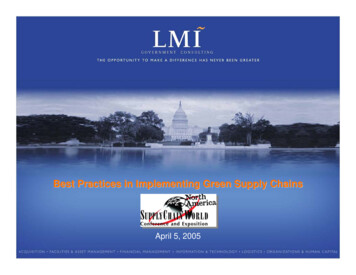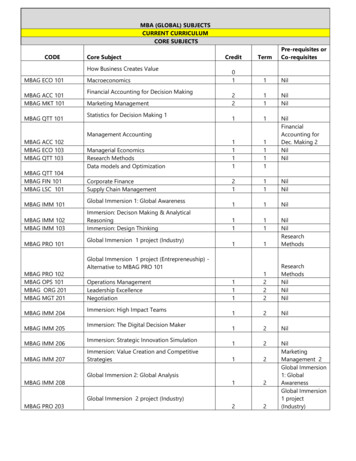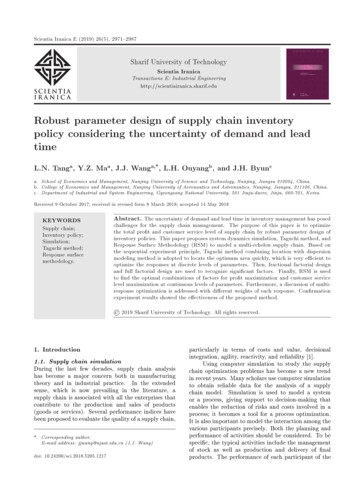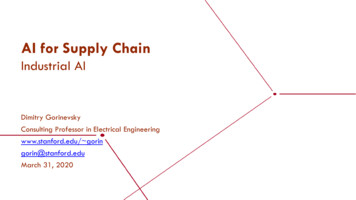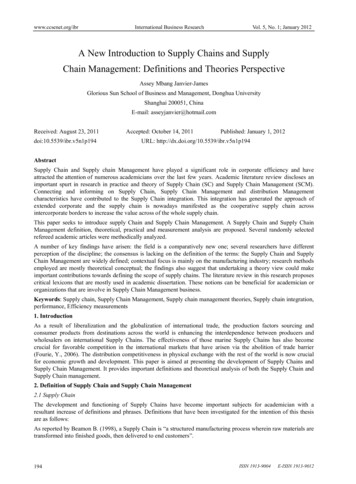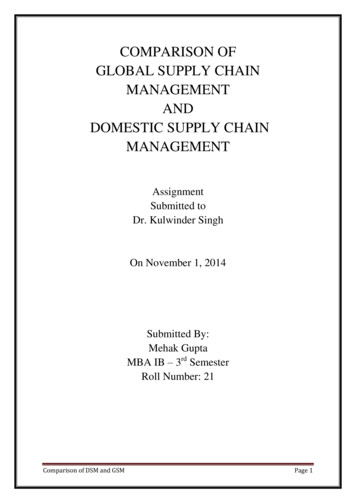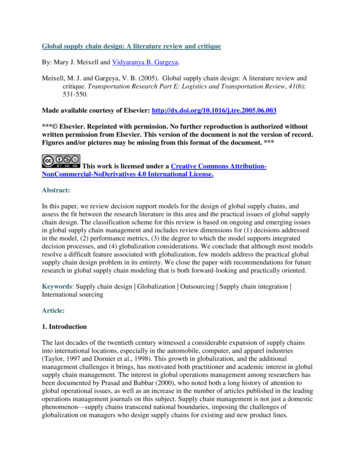
Transcription
Global supply chain design: A literature review and critiqueBy: Mary J. Meixell and Vidyaranya B. Gargeya.Meixell, M. J. and Gargeya, V. B. (2005). Global supply chain design: A literature review andcritique. Transportation Research Part E: Logistics and Transportation Review, 41(6):531-550.Made available courtesy of Elsevier: http://dx.doi.org/10.1016/j.tre.2005.06.003*** Elsevier. Reprinted with permission. No further reproduction is authorized withoutwritten permission from Elsevier. This version of the document is not the version of record.Figures and/or pictures may be missing from this format of the document. ***This work is licensed under a Creative Commons AttributionNonCommercial-NoDerivatives 4.0 International License.Abstract:In this paper, we review decision support models for the design of global supply chains, andassess the fit between the research literature in this area and the practical issues of global supplychain design. The classification scheme for this review is based on ongoing and emerging issuesin global supply chain management and includes review dimensions for (1) decisions addressedin the model, (2) performance metrics, (3) the degree to which the model supports integrateddecision processes, and (4) globalization considerations. We conclude that although most modelsresolve a difficult feature associated with globalization, few models address the practical globalsupply chain design problem in its entirety. We close the paper with recommendations for futureresearch in global supply chain modeling that is both forward-looking and practically oriented.Keywords: Supply chain design Globalization Outsourcing Supply chain integration International sourcingArticle:1. IntroductionThe last decades of the twentieth century witnessed a considerable expansion of supply chainsinto international locations, especially in the automobile, computer, and apparel industries(Taylor, 1997 and Dornier et al., 1998). This growth in globalization, and the additionalmanagement challenges it brings, has motivated both practitioner and academic interest in globalsupply chain management. The interest in global operations management among researchers hasbeen documented by Prasad and Babbar (2000), who noted both a long history of attention toglobal operational issues, as well as an increase in the number of articles published in the leadingoperations management journals on this subject. Supply chain management is not just a domesticphenomenon—supply chains transcend national boundaries, imposing the challenges ofglobalization on managers who design supply chains for existing and new product lines.
In this paper, we review articles pertaining to global supply chain design and focus on thelogistics of the supply chain, i.e., the movement of goods from the point of origin to the point ofconsumption (Vitasek, 2003). Fig. 1 illustrates alternative production locations for a globalsupply chain, depicting manufacturing activities for an end-product and for multiple tiers ofcomponents. The supply chain is arranged in tiers that represent production stages, which areorganized such that the outputs from one tier are the inputs to the next. For example, a factory inan apparel supply chain that produces plastic ships to a factory that uses that material to producezippers that are then shipped to a factory that assembles jackets. As depicted in Fig. 1, thesematerials, components, and end-products may be produced in company-owned or supplierfacilities, in either domestic or international locations.A supply chain design problem comprises the decisions regarding the number and location ofproduction facilities, the amount of capacity at each facility, the assignment of each marketregion to one or more locations, and supplier selection for sub-assemblies, components andmaterials (Chopra and Meindl, 2004). Global supply chain design extends this definition toinclude selection of facilities at international locations, and the special globalization factors thisinvolves. These design decisions may be decentralized, such that a manager at each facilitymakes decisions, or may be centralized so that decisions across facilities are coordinated. Ideally,managers make these choices consistent with the firm’s supply chain strategy.1.1 Ongoing issues in global supply chain designInternational manufacturing sources—whether company-owned or external suppliers—have inrecent years been sought out by managers because of reduced cost, increased revenues, andimproved reliability. Manufacturers typically set up foreign factories to benefit from tariff and
trade concessions, low cost direct labor, capital subsidies, and reduced logistics costs in foreignmarkets (Ferdows, 1997). Likewise, benefits accrue due to access to overseas markets,organizational learning though close proximity to customers, and improved reliability because ofclose proximity to suppliers (MacCormack et al., 1994).However, experts maintain that global supply chains are more difficult to manage than domesticsupply chains (Dornier et al., 1998, Wood et al., 2002 and MacCarthy and Atthirawong, 2003).Substantial geographical distances in these global situations not only increase transportationcosts, but complicate decisions because of inventory cost tradeoffs due to increased lead-time inthe supply chain. Different local cultures, languages, and practices diminish the effectiveness ofbusiness processes such as demand forecasting and material planning. Similarly, infrastructuraldeficiencies in developing countries in transportation and telecommunications, as well asinadequate worker skills, supplier availability, supplier quality, equipment and technologyprovide challenges normally not experienced in developed countries. These difficulties inhibitthe degree to which a global supply chain provides a competitive advantage.Furthermore, global supply chains carry unique risks that influence performance, includingvariability and uncertainty in currency exchange rates, economic and political instability, andchanges in the regulatory environment (Dornier et al., 1998). Currency exchange rates affect theprice paid for goods that are purchased in the supplier’s currency and so influence the timing andvolume of purchases as well as the financial performance of the supply chain (Carter andVickery, 1988 and Carter and Vickery, 1989). Accordingly, practitioners are well advised tofactor these risks into their decisions when designing global supply chains.1.2. Emerging issues in global supply chain designTo aid managers in solving these problems, the research community has developed numerousglobal supply chain design models. The business environment that surrounds the global supplychain problem is continually changing, however, as new issues in supply chain management andglobalization surface. First, firms are increasingly outsourcing to both domestic and globallocations. Second, many firms that had viewed their sourcing problems myopically as anenterprise-level concern now strive to integrate decision processes across tiers in the supplychain. A third issue is the broadened definition of supply chain performance, as mission, strategyand objectives can vary considerably based on the value of the product offered to the customer(Keeney, 1994).Outsourcing manufacturing to offshore supplier locations is a practice that has grown in recentyears such that managers find themselves increasingly designing supply chains that include notonly corporate but also supplier facilities. Supplier selection decisions change the global supplychain design problem in fundamental ways, in part because they are based on more broadlydefined criteria. Suppliers are typically selected based on the buyer’s perception of the supplier’sability to meet quality, quantity, delivery, price and service needs of the firm (Leenders et al.,2002). In some cases, purchasing managers consider an even broader set of criteria as defined bythe total cost of ownership to include the cost of carrying inventory, repair, training, disposal,etc. (Ellram, 1995, Degraeve and Roodhooft, 1999 and Burt et al., 2003). Ultimately, purchasingmanagers summarize these factors so that candidate suppliers may be ranked for selection.
Supplier contracts also influence the design problem structure with additional factors such asminimum order quantities, restrictions on the number of vendors, geographic preferences, andlimitations on supplier capacities (Pan, 1989).A second emerging issue—the integration of decisions across the supply chain—also influencesglobal supply chain design. Integrating business processes is a best practice in supply chainmanagement that involves coordinating decisions across multiple facilities and tiers. In practice,firms engaged in Vendor Managed Inventory (VMI) and Collaborative Planning, Forecasting,and Replenishment (CPFR) integrate replenishment planning between enterprises by sharingsales and promotion information (Sherman, 1998 and Lewis, 1999). Similarly, firms thatimplement Advanced Planning Systems (APS) may integrate production decisions across thesupply chain by including supplier inventory and capacity constraints into their schedulingfunction, striving to avert supply problems before they occur (Rohde, 2000 and Bowersox et al.,2002). These integration practices also affect global supply chain design. Several authors(Dornier et al., 1998, Brush et al., 1999 and Trent and Monczka, 2003) discuss the value andneed for integration between facilities in the global supply chain. An integrated, well-coordinatedglobal supply chain is difficult to duplicate and so plays an important role in competitivestrategy.To date, much of the emphasis in supply chain management has been on cost reduction, butperformance in real-world supply chains has multiple attributes. As defined in the Supply ChainOperations Reference (SCOR) model, performance is measured in terms of reliability,responsiveness, flexibility, cost, and assets (Supply-Chain Council, 2003).Additionally, Handfield (1994) mentions five benefits for companies who choose to sourceglobally—improving quality, meeting schedule requirements, reducing cost, accessing newtechnologies, and broadening the supply base. For example, throughout the 1990s, a number offirms adopted a quick-response strategy to improve competitiveness (Hammond,1990 and Lowson et al., 1999). Authors such as Bozarth et al. (1998) suggest deliveryperformance and quality as important measures in global supply chain management. Firms thathad previously looked to their international manufacturing sites as a source of low-costadvantage now rely on their global production sites for improved access to customers, suppliersand skilled employees (Ferdows, 1997). Managers who design global supply chains need to aligntheir decisions with the mission, objectives, and strategy of their firm, which is considerablybroader in scope than cost reduction.1.3. Plan for this researchThe purpose of this paper is to assess how well the existing model-based literature supports theglobal supply chain design problem, in light of these ongoing and emerging issues in the globalenvironment. Our contributions are threefold: the development of a classification scheme that isfocused on these practical considerations, a structured review that provides a guide to earlierresearch on the subject of global supply chain design models, and identification of researchissues for future investigation. In the next section, we describe the methodology for the review.Section 3 summarizes the selected research, followed in Section 4 by an analysis relative to the
practical issues in global supply chain design. In Section 5, we draw conclusions and suggestfuture research directions.2. Review methodologyIn this review, we focus on the model-based literature that addresses the global “supply chaindesign” problem. An alternate term in the research literature is “supply network design”, used bysome authors to signify that supply structures are often more complex than that suggested by achain. We used these and related keywords, and limited our selection to articles that describeglobal supply chain design models that incorporate international issues, variables, parametersand constraints. Global supply chain design models are in a special class and distinct fromgeneral supply chain design models, due to the differences in cost structure and complications ofinternational logistics.With this scope in mind, we conducted a search using library databases covering the majorjournals in management science and operations management, such as DecisionSciences, European Journal of Operational Research, Interfaces, International Journal ofOperations and Production Management, International Journal of ProductionEconomics, International Journal of Production Research, Journal of OperationsManagement, Management Science, Operations Research, Production and OperationsManagement, Transportation Research, etc. We also searched edited books and special issues onsupply chain management in Production and Operations Management (1997, 2002), DecisionSciences (1998, 2002), Interfaces (2000), and Industrial Marketing Management (2004).From these sources, we selected articles that span a little more than two decades, from 1982 to2005. More than 100 articles and books appeared on the subject of global supply chainmanagement during this period, so we screened them to a list of about 80 pertinent references onglobal supply chain design. Of these, 25 model-based articles were selected and summarized. Inmost cases, a representative publication was selected from those authors who have publishednumerous papers and reports on the subject, narrowing the list to 18 major research articlespublished in 12 journals and 1 book. When clustered on a temporal basis, four of the articleswere published prior to 1990, four in the 1991–1995 period, six in the 1996–2000 period, andfour after year 2000.Several earlier literature reviews have been conducted on aspects of global supply chain design.These include Verter and Dincer, 1992, Verter and Dincer, 1995, Vidal and Goetschalckx,1997, Goetschalckx et al., 2002, Cohen and Mallik, 1997, Cohen and Huchzermeier,1999 and Schmidt and Wilhelm, 2000. Many of these reviews seek a missing technical feature inthe existing model-based literature concerning global supply chain design. Our review differs inpurpose, as we seek to assess how well existing models support global supply chain designdecisions in light of globalization difficulties, outsourcing, integration, and strategic alignment.To assess this fit, we use four dimensions—decision variables, performance measurement,supply chain integration, and globalization considerations. The most common decision variablesin these models are facility selection, production/shipment quantities, and supplier selection. Wealso identify other decision variables from the model descriptions. The performance
measurement dimension identifies the nature of the objective function and other performanceconstructs such as constraints where they occur. For the supply chain integration dimension, weuse a category for the number of supply chain levels evaluated in the model, another for whethera bill of material is specified, and a third for the type of coordination. For globalizationconsiderations, we use the following categories: tariffs and duties, non-tariff trade barriers,currency exchange rate, corporate income tax, transportation time, inventory cost, worker skilland availability, and industry context. The currency exchange rate category reflects the use ofconversion factors, as well as explicit consideration for variability or uncertainty in the exchangerate. We account for each of these dimensions as reported by the authors in the research articles.3. Global supply chain design modelsIn this section, we review the selected research articles in chronological order. This orderingreflects both the issues that were important in global supply chain design at that time as well asthe decision and information technologies available to solve these problems. In Table 1, Table2, Table 3 and Table 4, we summarize the characteristics of the models along the four reviewdimensions.
In the models developed prior to 1990, corporate taxes, tariffs, and duties were prominent issues,and the favored technology was the production–distribution model. In the period between 1991and 1995, variability and uncertainty in exchange rates became primary concerns, and we seethat researchers developed stochastic programming and option valuation models to help addressthese concerns. Also during this period, researchers introduce objectives other than cost andprofit—for example, activity duration is used in some cases as the performance construct. Duringthe period from 1996 to 2000, there was continued interest in uncertainty in the parameters of theproblem, as well as attention to the transfer price and supplier selection decisions. Finally, in theperiod after 2000, researchers again expanded technologies used to tackle these problems,developing network equilibrium models and multi-phase approaches that deploy multipletechnologies.3.1. Models developed prior to 1990Early research on the global plant location problem appears in Hodder and Jucker, 1982,Hodderand Jucker, 1985 and Hodder and Dincer, 1986. Here, we focus on a representativepublication, Hodder and Dincer (1986). In this paper, the authors studied the international plantlocation problem and developed a single-period model to determine the best locations, materialflows and financing patterns. The model identifies the best sourcing plan given multiple possibleproduction sites for a product to be sold in multiple markets. The authors used a function ofafter-tax profit as the objective, computed as the difference between net revenue, fixed cost forhaving a plant open, and a cost for financing that allows borrowing in multiple currencies. Thecost of financing a plant is managed in the objective function as a single period outlay thatrepresents the sum of the acquisition and interest rate costs, in the numeraire currency (i.e., of thefirm’s home country), adjusted using the appropriate currency exchange rate. In this way, themodel includes both the costs and revenues shared across facilities, with a single time period thatis sufficiently long to reflect both the decisions and their consequences on the global operation.Hodder and Dincer (1986) also included the impact of financing arrangements, such assubsidization from local governments and reduction in corporate tax rates. The model uses amean-variance structure in the objective function to evaluate the risk associated with uncertainprice and exchange rates, allowing for correlation between price changes in global markets. Theauthors provided an approximation procedure that allows for solving problems that are typical ofthose observed in practice. The authors also allowed for several global cost factors, such asproduction and transportation costs, tariffs, taxes, and the appropriate exchange rate. However,the authors did not mention an industry application.Breitman and Lucas (1987) described the PLANETS model, developed at General Motors toassist in making decisions concerning facility location, capacity planning, material sourcing,product allocation, and new product introduction. PLANETS is a tool for building mixed integerprogramming models that are reportedly capable of providing optimal solutions to difficultglobal sourcing problems. The model maximizes any of a variety of objectives, depending on theparticular assumptions and business environment, including profit, market penetration, facilityutilization, exports, production, sales, costs, losses, investment, and imports. The authors use abill of material constraint in the model to allow for complex product structures that explicitly
link the quantity relationships between the facilities over multiple tiers in the global supplychain.Breitman and Lucas (1987) modeled a number of features relating to global supply chains,including tariffs, local content, balance of trade, and trade complementation. Global parametersin the model include currency exchange rates and transportation costs. The authors did notprovide the model formulation in the paper, and the level of integration in the supply chain wasnot specified. The authors state that the model has been applied to numerous studies in theautomotive industry.Cohen and Lee (1989) developed a global supply chain model and then evaluated a series ofpolicy options that a firm might use to establish a global manufacturing strategy. Thisproduction–distribution model consists of four tiers—component suppliers, final assemblyplants, distribution centers, and market locations. The model’s time horizon is such that thedecisions and associated costs occur in a single yet sufficiently long time period. The objectivemaximizes total global after-tax profits, including taxes, tariffs and transfer prices, all adjustedfor varying but known exchange rates. Because of the implications of corporate taxes on therevenue function, the model is non-linear with both integer and linear variables.In Cohen and Lee (1989), the supplier and assembly plant tiers are linked using a bill of materialspecified as a usage rate in the constraint set. The model selects vendors based on both fixed andvariable costs, and bounds the flows from the supplier plants for minimum and maximum supplycapacities. The authors stated that a realistic problem could likely not be solved in its entirety,and proposed a hierarchical procedure that relaxes the integer constraints. The paper describes acase study application from the personal computer manufacturing industry.Cohen et al. (1989) developed a global supply chain model to address the manufacturingdecisions faced by companies that produce and source globally. The model is a multi-period,production–distribution model with time-varying parameters that solves for both location andmaterial shipment quantities over time. The decision variables are supplier choice, the productionquantity at each plant, and the amount of product supplied to each market. The objectivemaximizes after-tax profits subject to material flow constraints, plant capacity, marketpenetration strategies and local content rules.Cohen et al. (1989) included a fixed-cost structure that allows for economies of scale in theproduction–distribution network. Other factors included tariffs, currency exchange rates, andcorporate tax rates. The model calculates after-tax profit based on transfer prices, but the pricesare an input and not a decision variable in the model. The model specifies vendor contractalternatives for cost, duration and volume limits, providing supplier selection capabilities that areuncommon but generally beneficial in supply chain design models. The model allows for threesupply chain tiers and provides for specification of a bill of material in its constraint set. Theauthors did not mention an industry application in this paper.3.2. Models developed in the 1990–1995 period
Haug (1992) developed an international location model to study the global sourcing problem inhigh technology firms. The model identifies the best sourcing plan given a set of possibleproduction sites for a product to be sold in multiple markets. The model is distinct in that itexplicitly recognizes learning-curve effects on both material and labor costs, and allows forproduction to be transferred from site to site in response to improved input costs or exchangerates. Because of learning curve effects, a penalty would be incurred at a new site until itbecomes as efficient as a former site. The model excludes fixed relocation costs because thesupplier firms, joint ventures, and internal facilities are previously established. Therefore, thesecharges are not incurred if and when production is transferred.The model described in Haug (1992) includes variable costs that are typically considered inlocation models, such as material, labor, transportation, and utilities. The output of the model is alocation sequence. In other words, the model identifies the best location for production, allowingproduction to be transferred from one site to another site at the beginning of each year. Threetypes of globalization considerations are explicitly considered in the model—exchange ratevariability, inflation variability, and changes in worker skill over time. However, the authors didnot mention an industry application.Kogut and Kulatilaka (1994) developed a stochastic, dynamic programming model to study thevalue of production switching in conditions where currency exchange rates are uncertain. In thisway, the authors investigated the flexibility of a manufacturing system that allows production tobe transferred as currency exchange rates fluctuate. The decision to stay to a production facilitywith unfavorable exchange rates versus shifting production to a facility with more favorable ratesis complicated by switching costs—shutdown and startup costs, labor related costs, andmanagerial time commitments.Kogut and Kulatilaka (1994) assumed that demand is independent of price and structured themodel to minimize a vector of factor costs, which includes transportation cost from theproduction facility to the market. The model allocates production for a single product in a singlemarket location to a set of possible production locations. The authors provided a numericalexample without identifying a specific industry application.Arntzen et al. (1995) developed a mixed integer program to solve the global supply chain designproblem at an electronics manufacturer, Digital Equipment Corporation, now part of the CompaqCorporation. The decision variables in the model are location selection and production, inventoryand shipping quantities. The model minimizes fixed and variable production costs, inventorycosts, and distribution expenses, including transportation, taxes, and duties with consideration forlocal content, offset trade, and duty drawback. The model solves supply chain problems thatinvolve multiple products, production stages, time periods, and transportation modes. The modelis highly integrative, since it links multiple supply tiers by the bill of material, and solves for theoptimal solution over both production and distribution segments of the supply chain.A distinguishing feature of the model by Arntzen et al. (1995) is its ability to reflect both costand time in the objective function. Time is measured as the number of days needed forproduction and for transit on each link in the supply chain, weighted by the number of unitsprocessed or shipped on the link. Thus the overall response time of the supply chain can be
minimized as an alternative objective. In fact, the objective function may be a weightedcombination of cost and time so that either measure or both can be used to deriverecommendations.Gutierrez and Kouvelis (1995) developed a model and an algorithm for international sourcingwith uncertain currency exchange rates and investigated the utility of operational flexibility tohedge against losses in this environment. The model minimizes the sum of fixed and variablecosts and selects suppliers for a global network that allows for production switching whenexchange rates fluctuate. The fixed costs represent the costs of developing a particular supplierlocation, such as joint engineering, transfer of technology, and quality improvement programs.The variable cost is the purchase price, which includes transportation cost and import/exporttaxes. The authors allowed for minimum purchase quantities in the model by breaking thevariable costs into two parts—costs associated with the minimum purchase quantity, and costsfor production in excess of the minimum.Gutierrez and Kouvelis (1995) structured this international sourcing model using a min-maxformulation so as to identify a supply network that is robust to changes in exchange rates.Specifically, the company entities included in the supply network are selected to minimize theperformance range under all exchange rate scenarios and so provides a robust solution. Thisresearch was extended in Kouvelis et al. (2001) to investigate ownership structure and theexchange rate conditions under which exporting, joint ventures, or wholly owned productionfacilities are appropriate.3.3. Models developed in the 1996–2000 periodCanel and Khumawala (1996) developed un-capacitated and capacitated versions of a mixedinteger programming model to solve an international facility location problem (IFLP). Theobjective maximizes after-tax profits, including costs for investment, fixed, transportation,shortage, and inventory holding. The model selects multiple production sources for end-productmanufacturing but not the supply segments. Prices are a parameter of the model and vary byselling country, so when production is limited the model chooses the best customer locations foreach facility. The model includes a number of features relating to global supply chains, includingexchange rates, corporate tax rates, tariffs, and direct export incentives. The authors illustratedthe model using a case study from the chemical industry.Canel and Khumawala (1997) extended the IFLP model by including multiple periods so thattiming of location changes can be more carefully evaluated. Later, Canel and Khumawala(2001) focused on heuristic procedures to solve the IFLP problem. Canel and Das (2002) extendthis research line with a model that integrates manufacturing and marketing decisions in a globalcontext.In Rosenfield (1996), the author developed a model to describe production and distribution costsfor an international location problem and then explored its structural properties to draw insightson location and capacity strategies when exchange rates are uncertain. The model assumes thatproduct
To date, much of the emphasis in supply chain management has been on cost reduction, but performance in real-world supply chains has multiple attributes. As defined in the Supply Chain Operations Reference (SCOR) model, performance is measured in terms of reliability, responsiveness, flexibility, cost, and assets (Supply-Chain Council, 2003).


